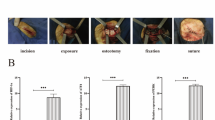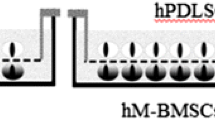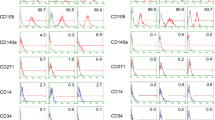Abstract
Bone reconstruction is essential in orthodontic treatment that caters to the correction of malocclusion by bone reconstruction. Mesenchymal stem cells (MSCs) have been demonstrated a great potency of osteogenesis. The aim of this study was to investigate the effect of hypoxia on the rat bone marrow MSCs (rBMSCs) in vitro during osteogenesis. In this study, we found that temporary exposure of rBMSCs after osteogenic induction for 7 days to hypoxia (2% oxygen) led to a marked decrease in ALPase activity and the expression of osteocalcin and Runt related transcription factor 2/core binding factor a1 (Runx2/Cbfa1). Meanwhile, we found that exposure to hypoxia led to an early and transient increase in the level of phosphorylated ERK1/2 but had no obvious effects on mitogen-activated protein kinase (p38 MAPK) level. Based on these results, we concluded that hypoxia could inhibit osteogenic differentiation of rBMSCs possibly through MEK-ERK 1/2, while p38 MAPK may not participate in this regulation. Further exploration into the mechanisms of hypoxia on osteogenesis would surely provide reliable evidence for clinical practice.





Similar content being viewed by others
Abbreviations
- ALPase:
-
Alkaline phosphatase
- OC:
-
Osteocalcin
- rBMSCs:
-
Rat bone marrow mesenchymal stem cells
- VEGF:
-
Vascular endothelial growth factor
- Runx2:
-
Runt related transcription factor 2
- Cbfa1:
-
Core binding factor a1
- hMSCs:
-
Human mesenchymal stem cells
References
Vandevska-Radunovic V (1999) Neural modulation of inflammatory reactions in dental tissues incident to orthodontic tooth movement. A review of the literature. Eur J Orthod 21:231–247
Gaengler P, Merte K (1983) Effects of force application on periodontal blood circulation. A vital microscopic study in rats. J Periodontal Res 18:86–92
Gianelly AA (1969) Force-induced changes in the vascularity of the periodontal ligament. Am J Orthod 55:5–11
Hosoyama M (1989) Changes in the microvascular pattern of the periodontium in an experimental tooth movement]. Nippon Kyosei Shika Gakkai Zasshi 48:425–442
Rygh P (1972) Ultrastructural cellular reactions in pressure zones of rat molar periodontium incident to orthodontic tooth movement. Acta Odontol Scand 30:575–593
Rygh P (1972) Ultrastructural vascular changes in pressure zones of rat molar periodontium incident to orthodontic movement. Scand J Dent Res 80:307–321
Castelli WA, Dempster WT (1965) The periodontal vasculature and its responses to experimental pressures. J Am Dent Assoc 70:890–905
Macapanpan LC, Weinmann JP (1954) The influence of injury to the periodontal membrane on the spread of gingival inflammation. J Dent Res 33:263–272
Heppenstall RB, Grislis G, Hunt TK (1975) Tissue gas tensions and oxygen consumption in healing bone defects. Clin Orthop 106:357–365
Gordillo GM, Hunt TK, Sen CK (2003) Significance of oxygen therapeutics. Wound Repair Regen 11:393; author reply 393
Rygh P, Selvig KA (1973) Erythrocyte crystallization in rat molar periodontium incident to tooth movement. Scand J Dent Res 81:62–73
Murrell EF, Yen EH, Johnson RB (1996) Vascular changes in the periodontal ligament after removal of orthodontic forces. Am J Orthod Dentofac Orthop 110:280–286
Azuma M (1970) Study on histologic changes of periodontal membrane incident to experimental tooth movement. Bull Tokyo Med Dent Univ 17:149–178
Warren SM, Steinbrech DS, Mehrara BJ, Saadeh PB, Greenwald JA, Spector JA, Bouletreau PJ, Longaker MT (2001) Hypoxia regulates osteoblast gene expression. J Surg Res 99:147–155
Brighton CT, Krebs AG (1972) Oxygen tension of nonunion of fractured femurs in the rabbit. Surg Gynecol Obstet 135:379–385
Heppenstall RB, Goodwin CW, Brighton CT (1976) Fracture healing in the presence of chronic hypoxia. J Bone Jt Surg Am 58:1153–1156
Akeno N, Czyzyk-Krzeska MF, Gross TS, Clemens TL (2001) Hypoxia induces vascular endothelial growth factor gene transcription in human osteoblast-like cells through the hypoxia-inducible factor-2alpha. Endocrinology 142:959–962
Steinbrech DS, Mehrara BJ, Saadeh PB, Chin G, Dudziak ME, Gerrets RP, Gittes GK, Longaker MT (1999) Hypoxia regulates VEGF expression and cellular proliferation by osteoblasts in vitro. Plast Reconstr Surg 104:738–747
Steinbrech DS, Mehrara BJ, Saadeh PB, Greenwald JA, Spector JA, Gittes GK, Longaker MT (2000) Hypoxia increases insulin like growth factor gene expression in rat osteoblasts. Ann Plast Surg 44:529–534; discussion 534–535
Brighton CT, Heppenstall RB (1971) Oxygen tension in zones of the epiphyseal plate, the metaphysis and diaphysis. An in vitro and in vivo study in rats and rabbits. J Bone Jt Surg Am 53:719–728
Shapiro IM, Boyde A (1987) Mineralization of normal and rachitic chick growth cartilage: vascular canals, cartilage calcification and osteogenesis. Scanning Microsc 1:599–606
Bruder SP, Fink DJ, Caplan AI (1994) Mesenchymal stem cells in bone development, bone repair, and skeletal regeneration therapy. J Cell Biochem 56:283–294
Raheja LF, Genetos DC, Yellowley CE (2008) Hypoxic osteocytes recruit human MSCs through an OPN/CD44-mediated pathway. Biochem Biophys Res Commun 366:1061–1066
Udagawa N, Takahashi N, Jimi E, Matsuzaki K, Tsurukai T, Itoh K, Nakagawa N, Yasuda H, Goto M, Tsuda E, Higashio K, Gillespie MT, Martin TJ, Suda T (1999) Osteoblasts/stromal cells stimulate osteoclast activation through expression of osteoclast differentiation factor/RANKL but not macrophage colony-stimulating factor: receptor activator of NF-kappa B ligand. Bone 25:517–523
Li J, Zhao Z, Yang J, Liu J, Wang J, Li X, Liu Y (2009) p38 MAPK mediated in compressive stress-induced chondrogenesis of rat bone marrow MSCs in 3D alginate scaffolds. J Cell Physiol 221:609–617
Liu J, Zhao Z, Li J, Zou L, Shuler C, Zou Y, Huang X, Li M, Wang J (2009) Hydrostatic pressures promote initial osteodifferentiation with ERK1/2 not p38 MAPK signaling involved. J Cell Biochem 107:224–232
Gerstenfeld LC, Cullinane DM, Barnes GL, Graves DT, Einhorn TA (2003) Fracture healing as a post-natal developmental process: molecular, spatial, and temporal aspects of its regulation. J Cell Biochem 88:873–884
Kofoed H, Sjontoft E, Siemssen SO, Oleson HP (1985) Bone marrow circulation after osteotomy. Acta Orthop Scand 56:400–403
Tùndevold E, Eriksen J, Jansen E (1979) Observations on long bone medullary pressures in relation to arterial pO2, pCO2 and pH in anaesthetized dog. Acta Orthop Scand 40:645–651
Ishikawa Y, Ito T (1988) Kinetics of hemopoietic stem cells in a hypoxic culture. Eur J Haematol 40:126–129
Lewis JS, Lee JA, Underwood JC, Harris AL, Lewis CE (1999) Macrophage responses to hypoxia: relevance to disease mechanisms. J Leukoc Biol 66:889–900
Ducy P (2000) Cbfa1: a molecular switch in osteoblast biology. Dev Dyn 219:461–471
Ontiveros C, Irwin R, Wiseman RW, McCabe LR (2004) Hypoxia suppresses Runx2 independent of modeled microgravity. J Cell Physiol 200:169–176
Park JH, Park BH, Kim HK, Park TS, Baek HS (2002) Hypoxia decreases Runx2/Cbfa1 expression in human osteoblast-like cells. Mol Cell Endocrinol 192:197–203
Salim A, Nacamuli RP, Morgan EF, Giaccia AJ, Longaker MT (2004) Transient changes in oxygen tension inhibit osteogenic differentiation and Runx2 expression in osteoblasts. J Biol Chem 279:40007–40016
Ducy P, Desbois C, Boyce B, Pinero G, Story B, Dunstan C, Smith E, Bonadio J, Goldstein S, Gundberg C, Bradley A, Karsenty G (1996) Increased bone formation in osteocalcin-deficient mice. Nature 382:448–452
Hirao M, Hashimoto J, Yamasaki N, Ando W, Tsuboi H, Myoui A, Yoshikawa H (2007) Oxygen tension is an important mediator of the transformation of osteoblasts to osteocytes. J Bone Miner Metab 25:266–276
Grayson WL, Zhao F, Izadpanah R, Bunnell B, Ma T (2006) Effects of hypoxia on human mesenchymal stem cell expansion and plasticity in 3D constructs. J Cell Physiol 207:331–339
Gruber R, Kandler B, Agis H, Fischer MB, Watzek G (2008) Bone cell responsiveness to growth and differentiation factors under hypoxia in vitro. Int J Oral Maxillofac Implants 23:417–426
Utting JC, Robins SP, Brandao-Burch A, Orriss IR, Behar J, Arnett TR (2006) Hypoxia inhibits the growth, differentiation and bone-forming capacity of rat osteoblasts. Exp Cell Res 312:1693–1702
Liu L, Zhang H, Sun L, Gao Y, Jin H, Liang S, Wang Y, Dong M, Shi Y, Li Z, Fan D (2010) ERK/MAPK activation involves hypoxia-induced MGr1-Ag/37LRP expression and contributes to apoptosis resistance in gastric cancer. Int J Cancer 127:820–829
Xiao G, Jiang D, Thomas P, Benson MD, Guan K, Karsenty G, Franceschi RT (2000) MAPK pathways activate and phosphorylate the osteoblast-specific transcription factor, Cbfa1. J Biol Chem 275:4453–4459
Acknowledgments
We greatly thank Zhiguang Su for carefully reading the manuscript. This work was supported by grants from the National Natural Science Foundation of China [No. 30870597, 30901698, and 30900286].
Author information
Authors and Affiliations
Corresponding authors
Additional information
Yating Wang and Juan Li have contributed equally to this work.
Rights and permissions
About this article
Cite this article
Wang, Y., Li, J., Wang, Y. et al. Effects of hypoxia on osteogenic differentiation of rat bone marrow mesenchymal stem cells. Mol Cell Biochem 362, 25–33 (2012). https://doi.org/10.1007/s11010-011-1124-7
Received:
Accepted:
Published:
Issue Date:
DOI: https://doi.org/10.1007/s11010-011-1124-7




